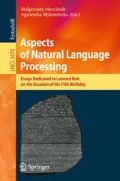Abstract
In the paper we address issues related to the morphology of the Uzbek language. In Uzbek, as in many other agglutinative languages, some single text-words correspond to sentences in non-agglutinative languages. Morphological processing is therefore a crucial operation in the automatic processing of Uzbek. We approach the theory of Uzbek morphology in terms of morphotactic and morphophonemic rules. We present the UZMORPP system of automatic morphological parsing for the Uzbek language. The Prolog implementation of this system is provided.
Access this chapter
Tax calculation will be finalised at checkout
Purchases are for personal use only
Preview
Unable to display preview. Download preview PDF.
References
—: Principal Orthographic Rules for the Uzbek Language. The Uzbekistan Cabinet of Minister’s Resolution No. 339, of August 24, 1995 (1995)
Gazdar, G., Mellish, C.: Natural Language Processing in Prolog. Addison-Wesley, Reading (1989)
Güngör, T., Kuru, S.: Representation of Turkish morphology in ATN. Booaziçi University, Istanbul (1993)
Pulatov, A., Juraeva, N.: Working out the formal model of the grammar of Uzbek language. Uzbek Mathematical Journal #1, Tashkent, Uzbekistan (2002)
Schlachter, J.G.: ProNTo Morph: Morphological Analysis Tool for use with ProNTo (Prolog Natural Language Toolkit), University of Georgia (2003), http://www.ai.uga.edu/mc/pronto (access 2008/11/01)
Usmonova, M., Azlarov, E., Sharipov, G.: O’zbek Tili. O’qituvchi, Toshkent (1991)
Vetulani, Z., Obrębski, T.: Morphological tagging of texts using the lemmatizer of the ‘POLEX’ electronic dictionary. In: Lewandowska-Tomaszczyk, B., Melia, P.J. (eds.) Practical Applications in Language Corpora, Proceedings, pp. 496–505. Łódź University Press, Łódź (1997)
Vetulani, Z.: Komunikacja człowieka z maszyną. Komputerowe modelowanie kompetencji językowej, Akademicka Oficyna Wydawnicza EXIT, Warszawa (2004)
Author information
Authors and Affiliations
Editor information
Editors and Affiliations
Rights and permissions
Copyright information
© 2009 Springer-Verlag Berlin Heidelberg
About this chapter
Cite this chapter
Matlatipov, G., Vetulani, Z. (2009). Representation of Uzbek Morphology in Prolog. In: Marciniak, M., Mykowiecka, A. (eds) Aspects of Natural Language Processing. Lecture Notes in Computer Science, vol 5070. Springer, Berlin, Heidelberg. https://doi.org/10.1007/978-3-642-04735-0_4
Download citation
DOI: https://doi.org/10.1007/978-3-642-04735-0_4
Publisher Name: Springer, Berlin, Heidelberg
Print ISBN: 978-3-642-04734-3
Online ISBN: 978-3-642-04735-0
eBook Packages: Computer ScienceComputer Science (R0)

